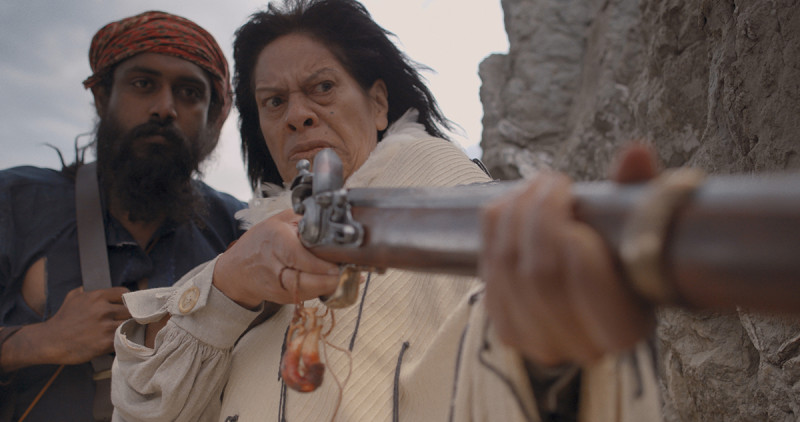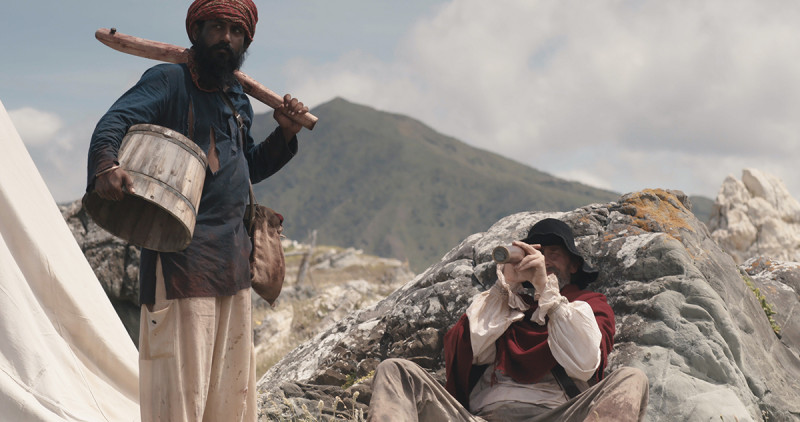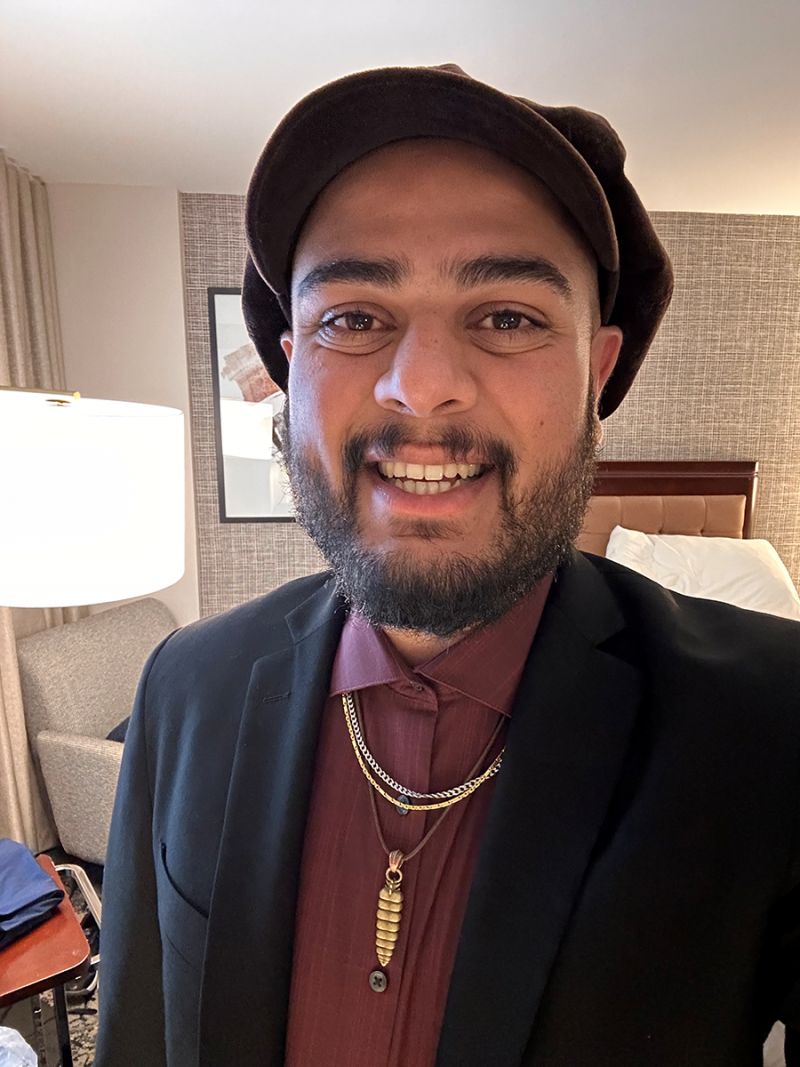
Still from The Lascar

Still from The Lascar

Adi Parige
Wellington Silver Screeners: Adi Parige by Alessia Belsito-Riera
In our Wellington Silver Screeners series, Alessia Belsito-Riera shines a spotlight on the movers and shakers working in the film capital of New Zealand.
Until recently, being born in New Zealand was just a random fact about filmmaker Adi Parige. The son of Indian immigrants working out of Aotearoa in the 90s, Parige was born at Wellington’s Newtown hospital by chance. Shortly after, the family relocated to California’s Bay Area where he grew up. Being born here “really had no meaning in my life until the pandemic when I decided to use my passport privilege to come to New Zealand,” he says. “Then everything spiralled.”
Intending to complete his master’s in film at Victoria University of Wellington – Te Herenga Waka, Parige used his studies as a vehicle to make his newest short film The Lascar, which recently picked up the Jury Award at the Alameda International Film Festival.
Congratulations on your win! Did you expect it or were you surprised?
I was pretty surprised! I was just very happy to be in the festival environment. Winning is a cherry on top but really the big prize is being in the room with other filmmakers. Getting to share our unique movie with other people and talk about the process with other filmmakers was the big highlight.
What sparked your interest in film? Did you have an ‘a-ha’ moment or was it a progression?
It’s definitely some mixture of both. There’s a very famous Bollywood song called Chaiyya Chaiyya. One of India’s big superstars is dancing and singing the song while on a moving train. When I was five I saw all of that and was like, ‘Ooh, me want’, and then discovered a lot of other stuff. But that was the catalyst moment. Growing up I was really into movies and then that interest carried on through making music videos and doing a lot of online work for people, and then also doing some advocacy work for anti-caste-system-related stuff within the Indian diaspora. All of those interests merged with my interest in history and then I got to this point of making this film.
What is The Lascar about?
There is a largely forgotten chapter of New Zealand history that’s been lost to the shipping logs of early colonialism. Part of that history is that amongst many of the early British East India Company ships to come to New Zealand were Indian sailors known as lascars. There are only a few anecdotes about who these men were. From the few we have, we can see the lascars getting in the middle of Māori and British conflicts and trading. Some of them even jumped ship because the conditions they were working under were pretty terrible. They got mixed up with local iwi, and some of it went okay, some of it didn’t. That intersectional history is fascinating. I treat The Lascar as a memorial to a fallen soldier equivalent. So, we created our own historical fiction narrative about an Indian sailor who gets caught up in the middle of a conflict between his British superior and two Māori siblings who he’s been trading with secretly.
As an Indian diaspora member, often I’ll find myself caught in between other bicultural narratives. In America that could be black and white, or Native American and whatever. In New Zealand it could be Māori and Pākehā. I think it’s a really interesting exercise to engage with those who are in between. Maybe their narrative is a minority narrative within the larger context, but it’s a really cool vantage point to explore and see things in a different light. As you watch the film, my lead sailor Dasa is our hero, but he’s not necessarily a great guy. He makes a lot of very selfish decisions in the context of just surviving.
One of the greatest things to happen in my life in the last five years is that my relationship with the country I was born in has a completely new meaning and it is largely built around making this film and finding the story. So many friends and collaborators and people I’m really inspired by came out of the woodwork to make this. That’s by far the coolest bit of it all.
What makes these stories and representation on screen so essential?
Representation is really, really important. It’s genuinely something I don’t think about too much because it’s a given that the stories I’m interested in are representing perspectives that are not given light to a lot. The Lascar is a unique film in the sense that it’s an intersectional movie. So it’s not a movie just about Indians, it’s about British people too – and within that, Scottish and English people – and Māori. I’m neither British nor Māori, nor am I an Indian sailor, so to really represent all of them I had to do a lot of digging and work with cultural consultants, which I think is such a simple solution to representation on screen. It was a transformative experience working with my kaiārahi [Māori advisor] Rob Thorne (Ngāti Tumutumu) who challenged me to think and engage with my own story. It’s sometimes tough as a writer to go to a cultural consultant, but if you’re not willing to engage with their feedback, you’re just going for the sake of it. Rob put that out for me at the forefront of our interaction, and then we really engaged with one another and what came out of it changed the story and the plot itself, but it gave the film a lot more weight.
What was the research process like?
I realised I didn’t know the history of Indians arriving in the Antipodes. I literally googled that and found a book called Indians in the Antipodes: Networks, Boundaries, and Circulation, which was compiled and partially written by Dr Sekhar Bandyopadhyay, who’s a professor of history at Victoria University of Wellington – Te Herenga Waka. The first chapter talks about Indian sailors who came to New Zealand to work in timber collection and in seal hunting. Immediately, as soon as I saw that, there were bells ringing in my head. From there, it was a really long process of not just reading about that particular chapter of history, but also learning about the larger experience of lascars in general. That process continued into my master’s programme. I kept reading, watching a lot of New Zealand cinema, and learning more about Māori culture. All of those things influenced the narrative and the direction of the research.
I loved the use of three languages in the film.
Thank you. I think it’s one of the more technical elements that I’m super stoked and intrigued about. I feel like I’ve only scratched the surface artistically of what I want to do with that. As a filmmaker I have my hands on everything, and letting go is a huge process of collaboration. Working with, for instance, the Urdu; I’m from South India, so my mother tongue is not Urdu. I worked with both of the Indian actors [Vinith Shiva and Mohammad Kunwar] but also my friend Farooq [Hussain] from New York. It was really interesting seeing him translate it, to learn what the translation was, and see how the reflection happens back into English. That happened again with the te reo – Mason Lawlor [Te Whānau-a-Apanui, Ngāti Awa, Ngāpuhi, Ngāti Kahungunu] did a really fantastic job. There are a lot of questions that come from it, like, what is an interaction between an Urdu and a te reo speaker? How much of each other are they actually understanding in this moment? What words do they know to get the transaction done?
I’ve been really inspired by what Denis Villeneuve has been saying about Dune recently. He’s not into dialogue as much as visual storytelling. I think what’s so interesting about communication breakdown is that you can have two languages on screen and when people don’t understand each other, it’s visual storytelling that helps us through, not dialogue.
How did you find filming in Wellington?
It’s so cool how receptive Wellington is to ideas, not just finished products. Again, it’s one of those things where I’m just like ‘Wow, I was born in this city!’ I found it really receptive as a city and as a culture to someone trying to do something different and new. While there are structures in place in the US for getting funding and making films, it’s hard to reach. In Wellington, you don’t have to reach as far to have a conversation about making something. Having a film commission is a huge thing. We didn’t work with them on this film, but we had the High Commission of India New Zealand, Auckland Tamil Association, and New Zealand Indian Central Association. Having those three come together to provide a huge chunk of our funding was something I’m really proud of, because the film was made by the people it’s about.
What’s next?
I’m not done with Wellington or New Zealand. This film is a proof of ability and concept. My goal is to turn this into a feature film. I think we got to barely scratch the surface of these interactions. There are so many elements of this world – I would love to be more specific about the iwi that the Māori characters come from and their relationship with their iwi, as well as the Indian sailors’ relationships with the motherland and the ship. I think the film The Nightingale does a really good job showing that ground zero for British colonialism is Ireland and other British people. I’d like to involve all that to delve deeper into the intersections that this historical period was built around. But this is its own standalone story. I have a different story with different characters for a feature. That’s my goal for coming back to New Zealand. I can’t just show up in Wellington and make a coming-of-age film about someone growing up in the 2000s, that’s not my story. But I feel I can lead a story about this in particular. We’re hoping that we’ll have some more luck with festivals this year in New Zealand because we would love to show the film on the big screen. This film is for Kiwis more than anyone else.
View more articles from:
« Issue 221, June 4, 2024

